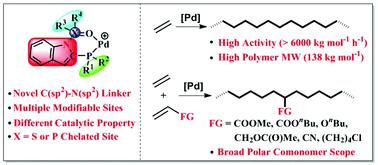当前位置:
X-MOL 学术
›
Polym. Chem.
›
论文详情
Our official English website, www.x-mol.net, welcomes your
feedback! (Note: you will need to create a separate account there.)
Indole-bridged bisphosphine-monoxide palladium catalysts for ethylene polymerization and copolymerization with polar monomers
Polymer Chemistry ( IF 4.1 ) Pub Date : 2020-03-18 , DOI: 10.1039/d0py00100g Kangkang Li 1, 2, 3, 4, 5 , Junhao Ye 1, 2, 3, 4, 5 , Zhen Wang 1, 2, 3, 4, 5 , Hongliang Mu 1, 2, 3, 4, 5 , Zhongbao Jian 1, 2, 3, 4, 5
Polymer Chemistry ( IF 4.1 ) Pub Date : 2020-03-18 , DOI: 10.1039/d0py00100g Kangkang Li 1, 2, 3, 4, 5 , Junhao Ye 1, 2, 3, 4, 5 , Zhen Wang 1, 2, 3, 4, 5 , Hongliang Mu 1, 2, 3, 4, 5 , Zhongbao Jian 1, 2, 3, 4, 5
Affiliation

|
Indole was, for the first time, used to bridge bisphosphine monoxide (BPMO) ligands and thus to construct efficient ethylene (co)polymerization palladium catalysts. By utilizing the indole framework, N(sp2)–C(sp2) linked BPMO-Pd complexes 2a–2g with various P(III) substituents, various P(V)![[double bond, length as m-dash]](https://www.rsc.org/images/entities/char_e001.gif) O substituents, and different X
O substituents, and different X![[double bond, length as m-dash]](https://www.rsc.org/images/entities/char_e001.gif) O moieties (S
O moieties (S![[double bond, length as m-dash]](https://www.rsc.org/images/entities/char_e001.gif) O versus P
O versus P![[double bond, length as m-dash]](https://www.rsc.org/images/entities/char_e001.gif) O) were synthesized and fully characterized by 1H, 13C, 31P, and 2D-NMR spectroscopy, elemental analysis, and single-crystal X-ray diffraction. In the presence of NaBArF, these complexes showed completely different activities (0–6210 kg mol−1 h−1) for ethylene polymerization, and generated obviously different molecular weight polyethylenes, with the highest molecular weight being 138 kg mol−1. Preferred palladium catalysts also enabled the copolymerization of ethylene with various commercially available polar monomers such as acrylates, vinyl butyl ether, allyl acetate, acrylonitrile, and 6-chloro-1-hexene to give essentially linear functionalized polyethylenes with comonomer incorporations of 0.3–3.3 mol%. Compared with pioneering C(sp2)–C(sp2) and N(sp2)-bridged analogues, the palladium catalysts in this contribution displayed different correlations between substituents and catalytic properties, which reflects the crucial role of backbone structures and potentially creates new opportunities in catalyst designing.
O) were synthesized and fully characterized by 1H, 13C, 31P, and 2D-NMR spectroscopy, elemental analysis, and single-crystal X-ray diffraction. In the presence of NaBArF, these complexes showed completely different activities (0–6210 kg mol−1 h−1) for ethylene polymerization, and generated obviously different molecular weight polyethylenes, with the highest molecular weight being 138 kg mol−1. Preferred palladium catalysts also enabled the copolymerization of ethylene with various commercially available polar monomers such as acrylates, vinyl butyl ether, allyl acetate, acrylonitrile, and 6-chloro-1-hexene to give essentially linear functionalized polyethylenes with comonomer incorporations of 0.3–3.3 mol%. Compared with pioneering C(sp2)–C(sp2) and N(sp2)-bridged analogues, the palladium catalysts in this contribution displayed different correlations between substituents and catalytic properties, which reflects the crucial role of backbone structures and potentially creates new opportunities in catalyst designing.
中文翻译:

用于乙烯聚合和与极性单体共聚的吲哚桥联双膦一氧化钯催化剂
吲哚首次用于桥接一氧化二膦(BPMO)配体,从而构建高效的乙烯(共)聚合钯催化剂。通过利用吲哚骨架,N(SP 2)-C(SP 2)连接的BPMO -钯复合物2A-2G与各种P(III)取代基,各个P(V)![[双键,长度为m-破折号]](https://www.rsc.org/images/entities/char_e001.gif) ø取代基,和不同的X
ø取代基,和不同的X ![[双键,长度为m-破折号]](https://www.rsc.org/images/entities/char_e001.gif) ö部分(S
ö部分(S ![[双键,长度为m-破折号]](https://www.rsc.org/images/entities/char_e001.gif) Ò与P
Ò与P ![[双键,长度为m-破折号]](https://www.rsc.org/images/entities/char_e001.gif) O)合成并通过1 H,13 C,31完全表征P和2D-NMR光谱,元素分析和单晶X射线衍射。在NaBArF的存在下,这些络合物显示出完全不同的乙烯聚合活性(0–6210 kg mol -1 h -1),并产生了明显不同的分子量聚乙烯,最高分子量为138 kg mol -1。优选的钯催化剂还能够使乙烯与各种可商购的极性单体(例如丙烯酸酯,乙烯基丁基醚,乙酸烯丙酯,丙烯腈和6-氯-1-己烯)共聚,从而制得基本线性的官能化聚乙烯,共聚单体掺入量为0.3-3.3摩尔。 %。与首创C(sp 2)–C(sp 2)和N(sp2)-桥接类似物,钯催化剂在取代基和催化性能之间显示出不同的相关性,这反映了骨架结构的关键作用,并可能在催化剂设计中创造新的机会。
O)合成并通过1 H,13 C,31完全表征P和2D-NMR光谱,元素分析和单晶X射线衍射。在NaBArF的存在下,这些络合物显示出完全不同的乙烯聚合活性(0–6210 kg mol -1 h -1),并产生了明显不同的分子量聚乙烯,最高分子量为138 kg mol -1。优选的钯催化剂还能够使乙烯与各种可商购的极性单体(例如丙烯酸酯,乙烯基丁基醚,乙酸烯丙酯,丙烯腈和6-氯-1-己烯)共聚,从而制得基本线性的官能化聚乙烯,共聚单体掺入量为0.3-3.3摩尔。 %。与首创C(sp 2)–C(sp 2)和N(sp2)-桥接类似物,钯催化剂在取代基和催化性能之间显示出不同的相关性,这反映了骨架结构的关键作用,并可能在催化剂设计中创造新的机会。
更新日期:2020-04-24
![[double bond, length as m-dash]](https://www.rsc.org/images/entities/char_e001.gif) O substituents, and different X
O substituents, and different X![[double bond, length as m-dash]](https://www.rsc.org/images/entities/char_e001.gif) O moieties (S
O moieties (S![[double bond, length as m-dash]](https://www.rsc.org/images/entities/char_e001.gif) O versus P
O versus P![[double bond, length as m-dash]](https://www.rsc.org/images/entities/char_e001.gif) O) were synthesized and fully characterized by 1H, 13C, 31P, and 2D-NMR spectroscopy, elemental analysis, and single-crystal X-ray diffraction. In the presence of NaBArF, these complexes showed completely different activities (0–6210 kg mol−1 h−1) for ethylene polymerization, and generated obviously different molecular weight polyethylenes, with the highest molecular weight being 138 kg mol−1. Preferred palladium catalysts also enabled the copolymerization of ethylene with various commercially available polar monomers such as acrylates, vinyl butyl ether, allyl acetate, acrylonitrile, and 6-chloro-1-hexene to give essentially linear functionalized polyethylenes with comonomer incorporations of 0.3–3.3 mol%. Compared with pioneering C(sp2)–C(sp2) and N(sp2)-bridged analogues, the palladium catalysts in this contribution displayed different correlations between substituents and catalytic properties, which reflects the crucial role of backbone structures and potentially creates new opportunities in catalyst designing.
O) were synthesized and fully characterized by 1H, 13C, 31P, and 2D-NMR spectroscopy, elemental analysis, and single-crystal X-ray diffraction. In the presence of NaBArF, these complexes showed completely different activities (0–6210 kg mol−1 h−1) for ethylene polymerization, and generated obviously different molecular weight polyethylenes, with the highest molecular weight being 138 kg mol−1. Preferred palladium catalysts also enabled the copolymerization of ethylene with various commercially available polar monomers such as acrylates, vinyl butyl ether, allyl acetate, acrylonitrile, and 6-chloro-1-hexene to give essentially linear functionalized polyethylenes with comonomer incorporations of 0.3–3.3 mol%. Compared with pioneering C(sp2)–C(sp2) and N(sp2)-bridged analogues, the palladium catalysts in this contribution displayed different correlations between substituents and catalytic properties, which reflects the crucial role of backbone structures and potentially creates new opportunities in catalyst designing.
中文翻译:

用于乙烯聚合和与极性单体共聚的吲哚桥联双膦一氧化钯催化剂
吲哚首次用于桥接一氧化二膦(BPMO)配体,从而构建高效的乙烯(共)聚合钯催化剂。通过利用吲哚骨架,N(SP 2)-C(SP 2)连接的BPMO -钯复合物2A-2G与各种P(III)取代基,各个P(V)
![[双键,长度为m-破折号]](https://www.rsc.org/images/entities/char_e001.gif) ø取代基,和不同的X
ø取代基,和不同的X ![[双键,长度为m-破折号]](https://www.rsc.org/images/entities/char_e001.gif) ö部分(S
ö部分(S ![[双键,长度为m-破折号]](https://www.rsc.org/images/entities/char_e001.gif) Ò与P
Ò与P ![[双键,长度为m-破折号]](https://www.rsc.org/images/entities/char_e001.gif) O)合成并通过1 H,13 C,31完全表征P和2D-NMR光谱,元素分析和单晶X射线衍射。在NaBArF的存在下,这些络合物显示出完全不同的乙烯聚合活性(0–6210 kg mol -1 h -1),并产生了明显不同的分子量聚乙烯,最高分子量为138 kg mol -1。优选的钯催化剂还能够使乙烯与各种可商购的极性单体(例如丙烯酸酯,乙烯基丁基醚,乙酸烯丙酯,丙烯腈和6-氯-1-己烯)共聚,从而制得基本线性的官能化聚乙烯,共聚单体掺入量为0.3-3.3摩尔。 %。与首创C(sp 2)–C(sp 2)和N(sp2)-桥接类似物,钯催化剂在取代基和催化性能之间显示出不同的相关性,这反映了骨架结构的关键作用,并可能在催化剂设计中创造新的机会。
O)合成并通过1 H,13 C,31完全表征P和2D-NMR光谱,元素分析和单晶X射线衍射。在NaBArF的存在下,这些络合物显示出完全不同的乙烯聚合活性(0–6210 kg mol -1 h -1),并产生了明显不同的分子量聚乙烯,最高分子量为138 kg mol -1。优选的钯催化剂还能够使乙烯与各种可商购的极性单体(例如丙烯酸酯,乙烯基丁基醚,乙酸烯丙酯,丙烯腈和6-氯-1-己烯)共聚,从而制得基本线性的官能化聚乙烯,共聚单体掺入量为0.3-3.3摩尔。 %。与首创C(sp 2)–C(sp 2)和N(sp2)-桥接类似物,钯催化剂在取代基和催化性能之间显示出不同的相关性,这反映了骨架结构的关键作用,并可能在催化剂设计中创造新的机会。











































 京公网安备 11010802027423号
京公网安备 11010802027423号